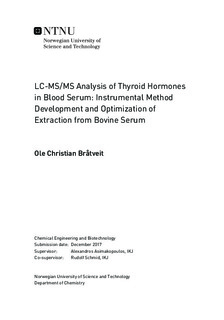LC-MS/MS Analysis of Thyroid Hormones in Blood Serum: Instrumental Method Development and Optimization of Extraction from Bovine Serum
Master thesis
Permanent lenke
http://hdl.handle.net/11250/2491333Utgivelsesdato
2017Metadata
Vis full innførselSamlinger
- Institutt for kjemi [1394]
Sammendrag
Thyroid hormones are a class of hormones that are essential to mammals for maintaining normal cell functions. In this study, we developed an instrumental method for the analysis of four thyroid hormones: L-Thyroxine (T4), 3,3′,5′-Triiodo-L-thyronine (rT3), 3,3′,5-Triiodo-L-thyronine (T3), and 3, 3′-Diiodo-L-thyronine (T2), using liquid chromatography (LC) tandem mass spectrometry (MS/MS). For optimal chromatographic separation we evaluated two LC columns, Atlantis T3 3μm (2.1 x 150mm) and Kinetex 1.7μm C18 (2.1 x 150mm) column. The performance characteristics of the instrumental method were evaluated, including, repeatability, ion ratio, retention and relative retention time, correlation coefficients, linear range, and limits of detection and quantification. To effectively analyze these thyroid hormones in bovine blood serum, a Liquid-Liquid extraction (LLE), two Solid-Phase Extraction (SPE), and two Hybrid Solid-Phase Extraction (Hybrid SPE-PPT) protocols were evaluated for extraction purposes. The Hybrid SPE-PPT cartridge is a novelty in the field of bioanalysis, and still, its applications are not fully explored. The Hybrid SPE cartridge is consisted of a zirconium packed-bed/low porosity filter/0.2 m hydrophobic frit assembly, where phospholipids are retained specifically to the zirconium sorbent, while proteins are retained non-specifically to the low porosity filter of the assembly. The absolute and relative recoveries (to the D2-T4 internal standard) were assessed. Moreover, the matrix effects that derived from every sample preparation protocol and impacted LC-MS/MS analysis, were evaluated. The instrumental calibration range for each thyroid hormone ranged from 0.25 to 100 ng/mL and showed excellent correlation coefficients linearity (r > 0.99). The instrumental detection and quantification limits ranged from 0.16-0.77 and 0.52-2.54 ng/mL, respectively. The selection of the optimal extraction method was made based on time-efficiency, optimal recoveries, and low matrix effects.
